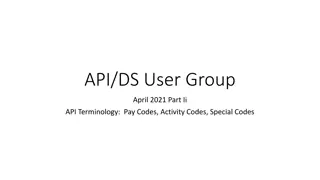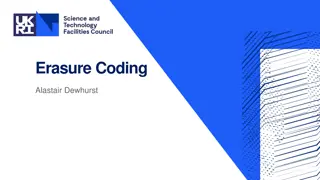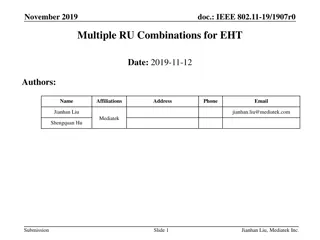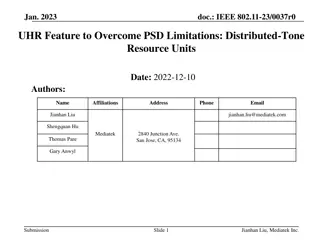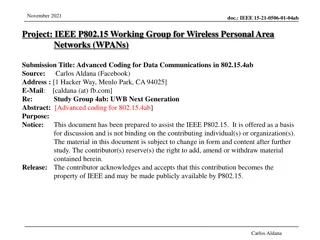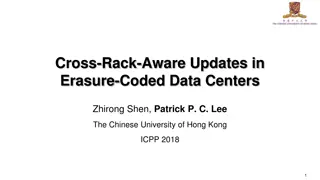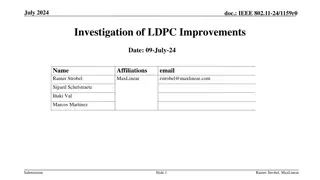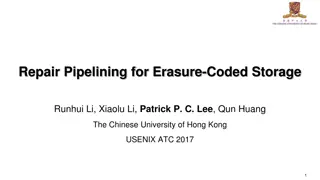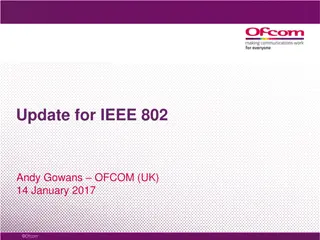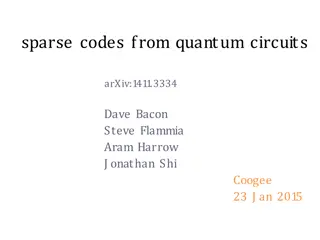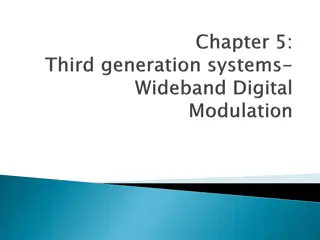Enhancing Spectrum Efficiency with Low Complexity Erasure Codes in IEEE 802.11 Document
This document delves into the implementation of erasure codes for content channels in IEEE 802.11 systems. By utilizing erasure codes, spectrum efficiency can be boosted without significantly increasing the complexity of encoding and decoding processes. The discussion also covers the duplication of content channels to accommodate bandwidth requirements, emphasizing the need for more efficient design in Extended HE (EHT) content channels compared to High-Efficiency (HE) channels. The potential of low complexity erasure codes, such as RDP codes, is highlighted for enhancing flexibility in puncturing patterns and overall spectrum efficiency in EHT content channels.
Download Presentation

Please find below an Image/Link to download the presentation.
The content on the website is provided AS IS for your information and personal use only. It may not be sold, licensed, or shared on other websites without obtaining consent from the author. Download presentation by click this link. If you encounter any issues during the download, it is possible that the publisher has removed the file from their server.
E N D
Presentation Transcript
March 2020 doc.: IEEE 802.11-20/0474r0 Remarks on the content channels Date: 2020-03-14 Authors: Name Miguel L pez Affiliations Ericsson Address Phone email Miguel.m.lopez@ericsson.co m Dennis Sundman Ericsson Leif Wilhelmsson Ericsson Submission Slide 1 Miguel L pez, Ericsson
March 2020 doc.: IEEE 802.11-20/0474r0 Abstract This contribution discusses the coding of the content channels It is shown that applying erasure codes results in both an increase of spectrum efficiency and more flexibility in the RU puncturing patterns, while the cost in terms of encoding/decoding complexity is very slight Submission Slide 2 Miguel L pez, Ericsson
March 2020 doc.: IEEE 802.11-20/0474r0 Recap The HE-SIG-B field comprises one or two HE-SIG-B content channels. Each HE-SIG-B content channel conveys user allocation for one or more 20 MHz subchannels An HE MU PPDU with bandwidth greater than 20 MHz has two HE-SIG- B content channels The content channels are duplicated when the PPDU bandwidth exceeds 40 MHz Submission Slide 3 Miguel L pez, Ericsson
March 2020 doc.: IEEE 802.11-20/0474r0 Content channels in EHT EHT will support larger bandwidths and more RU combinations than HE EHT will also support up to 16 SS MU PPDU than in one HE MU PPDU there could be more users in one EHT Therefore, the EHT content channels are expected to consume more bandwidth than the HE content channels Hence, it is highly desirable to make the design of the EHT content channels more spectrally efficient than the design of the HE content channels, as well as more flexible to support more RU combinations Submission Slide 4 Miguel L pez, Ericsson
March 2020 doc.: IEEE 802.11-20/0474r0 Low complexity erasure codes Erasure codes with very low encoding and decoding complexity (e.g. RDP codes and their extensions [1]) have been developed for applications such as Redundant Arrays of Inexpensive Disks (RAID). Low complexity erasure codes could also be applied in order to recover data erased due to preamble puncturing Low complexity erasure codes could be applied to the EHT content channels, instead of duplication, to increase both the flexibility in puncturing patterns and the spectrum efficiency Submission Slide 5 Miguel L pez, Ericsson
March 2020 doc.: IEEE 802.11-20/0474r0 Example 1: Increased flexibility in the puncturing patterns (1) We illustrate, by means of an example, how low complexity erasure codes can be used to increase the flexibility in the allowed puncturing patterns. Consider the example presented in great detail in [2]: 20 MHz 20 MHz 20 MHz 20 MHz 20 MHz 20 MHz 20 MHz 20 MHz Primary Primary 40 MHz idle busy idle busy idle idle idle idle content ch 1 content ch 2 content ch 1 content ch 2 content ch 1 content ch 2 content ch 1 content ch 2 Primary 80 MHz Secondary 80 MHz In this case the bandwidth of an HE MU PPDU can t exceed 20 MHz Submission Slide 6 Miguel L pez, Ericsson
March 2020 doc.: IEEE 802.11-20/0474r0 Example 1: Increased flexibility in the puncturing patterns (2) A low complexity erasure code with rate may be applied as shown in the figure: Submission Slide 7 Miguel L pez, Ericsson
March 2020 doc.: IEEE 802.11-20/0474r0 Example 1: Increased flexibility in the puncturing patterns (3) Further, the content channels are repeated on the 80 MHz secondary: 20 MHz 20 MHz 20 MHz 20 MHz 20 MHz 20 MHz 20 MHz 20 MHz Primary 80 MHz Secondary 80 MHz EHT SIG Encoded content channel (bn) EHT SIG Encoded content channel (gn) EHT SIG Encoded content channel (dn) EHT SIG Encoded content channel ( n) repetition Erasure encoded fields. Any two of these 4 fields can be punctured with erasure encoding an EHT MU PPDU could have 120 MHz bandwidth and support puncturing of any pair of 20 MHz channels Complexity of erasure code: Encoding: 0.5 XORs per bit. Decoding: 1 XOR per bit (see Appendix A) Submission Slide 8 Miguel L pez, Ericsson
March 2020 doc.: IEEE 802.11-20/0474r0 Example 2: Increased spectrum efficiency (1) We illustrate, by means of an example, how low complexity erasure codes can be used to increase the spectrum efficiency of the content channels. Consider an 80 MHz HE MU PPDU: 20 MHz Primary 20 MHz 20 MHz 20 MHz 20 MHz Primary 40 MHz secondary 40 MHz HE-SIG-B HE-SIG-B HE-SIG-B HE-SIG-B content ch 1 content ch 1 content ch 2 content ch 2 repetition Submission Slide 9 Miguel L pez, Ericsson
March 2020 doc.: IEEE 802.11-20/0474r0 Example 2: Increased spectrum efficiency (2) HE supports the following puncturing patterns for 80 MHz MU PPDUs: 20 MHz 20 MHz 20 MHz 20 MHz 20 MHz 20 MHz 20 MHz 20 MHz PPDU not transmitted busy idle idle idle Idle idle content ch 1 content ch 1 content ch 2 busy idle Idle busy content ch 1 idle idle content ch 2 content ch 2 Idle idle content ch 1 content ch 1 idle busy content ch 2 Clear channel assesment Transmission Submission Slide 10 Miguel L pez, Ericsson
March 2020 doc.: IEEE 802.11-20/0474r0 Example 2: Increased spectrum efficiency (3) EHT: Increase the number of content channels from 2 to 3 (50% increase) Apply a low complexity, rate 2/3 erasure code to the nonprimary channels (see Appendix B) 20 MHz 20 MHz Primary 20 MHz 20 MHz 20 MHz Primary 40 MHz secondary 40 MHz EHT-SIG Erasure encoded EHT-SIG Erasure encoded EHT-SIG Erasure encoded content ch EHT-SIG content ch 1 content ch content ch An 80 MHz EHT MU PPDU could support the same puncturing as an 80 MHz HE MU PPDU but the spectrum efficiency of the content channels could be increased by 50% Slide 11 Submission Miguel L pez, Ericsson
March 2020 doc.: IEEE 802.11-20/0474r0 Summary It has been shown, by means of relevant examples, that erasure codes can be applied to the EHT content channels in order to 1. Allow more RU combinations without increasing the bandwidth of the content channels 2. Increase the spectrum efficiency of the EHT content channels Furthermore, erasure codes with very low encoding/decoding complexity (e.g. RDP codes[1]) are well known Submission Slide 12 Miguel L pez, Ericsson
March 2020 doc.: IEEE 802.11-20/0474r0 References [1] Mario Blaum, A Family of MDS Array Codes with Minimal Number of Encoding Operations 2006 IEEE International Symposium on Information Theory (https://ieeexplore.ieee.org/document/4036480) [2] Oded Redlich et al., IEEE 802.11/20-0058-00-00be Preamble puncturing for transmission to multiple STAs in 802.11be , Jan 2020. Submission Slide 13 Miguel L pez, Ericsson
March 2020 doc.: IEEE 802.11-20/0474r0 Straw poll Do you agree that TGbe should consider the use of low complexity erasure codes in the design of the content channels? Y: N: A: Submission Slide 14 Miguel L pez, Ericsson
March 2020 doc.: IEEE 802.11-20/0474r0 Appendix A RDP codes and their extensions (see e.g. [1]) have low encoding and decoding complexity. The content channels could be encoded as shown in the figure Submission Slide 15 Miguel L pez, Ericsson
March 2020 doc.: IEEE 802.11-20/0474r0 Appendix A (cont.) Suppose that each content channel conveys N bits, say ?? ?=0 ?? ?=0 is the following. ? 1 and ? 1. An example of a low complexity erasure code with rate from [1] Encoding. Four sequences of code bits ??, ??, ??, ?? are generated (here | means XOR): ??= ??, ??= ??, ??= ??|??, ?2?= ?2?|?2?+1, ?2?+1= ?2?|?2?+1. Submission Slide 16 Miguel L pez, Ericsson
March 2020 doc.: IEEE 802.11-20/0474r0 Appendix A (cont.) Decoding, assuming that two of the four signal fields have been erased Signaling fields #3 and #4 are erased ??= ?? ??= ?? Signaling fields #2 and #4 are erased ??= ?? ??= ??|?? Signaling fields #1 and #4 are erased ??= ??|?? ??= ?? Submission Slide 17 Miguel L pez, Ericsson
March 2020 doc.: IEEE 802.11-20/0474r0 Appendix A (cont.) Signaling fields #2 and #3 are erased ??= ?? ?2?= ?2?+1|?2?+1 ?2?+1= ?2?|?2?| ?2? Signaling fields #1 and #3 are erased ??= ?? ?2?+1= ?2?+1|?2? ?2?= ?2?|?2?+1|?2? Signaling fields #1 and #2 are erased ?2?+1= ?2?|?2? ?2?+1= ?2?+1| ?2?+1 ?2?= ?2?+1| ?2?+1 ?2?= ?2?| ?2? Submission Slide 18 Miguel L pez, Ericsson
March 2020 doc.: IEEE 802.11-20/0474r0 Appendix B Suppose that there are four 20 MHz signal fieds, 3 content channels and each content channel conveys N bits, say ?? ?=0 ? 1, ?? ?=0 ? 1 and ?? ?=0 ? 1. Encoding. The first content channel is not ??coded The content channels ??and ??are encoded as follows. Three sequences of code bits ??, ??, ?? are generated (here | means XOR): ??= ??, ??= ??, ??= ??|??. Submission Slide 19 Miguel L pez, Ericsson
March 2020 doc.: IEEE 802.11-20/0474r0 Appendix B (cont.) The mapping to the 4 sig fields as follows. ?? ????????? ????? #1,??????? 20 ??? ?? ????????? ????? #2, ?? ????????? ????? #3, ?? ????????? ????? #4. Decoding. Suppose the second field ??is punctured. Then ??= ??|??. Suppose the third field ??is punctured. Then ??= ??|??. No decoding is necessary if the fourth field is punctured Submission Slide 20 Miguel L pez, Ericsson





